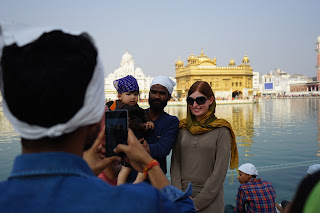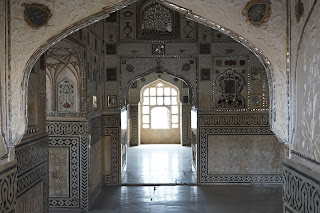L'hotel est à coté de la station Grant Road, au centre nord de Mumbai. Le gérant nous conseille de marcher jusqu'à la plage qui serait à 5mn à pied, finalement c'était plus 15mn avec traversé d'une route 6 voies... Un peu stressant mais les enfants qui font caca dans la rue et sur la plage
nous distraient un peu. Puis nous nous promenons sur Marine Drive à la recherche d'un resto.
Le lendemain nous visitons le centre de Mumbai, avec la gare CST (Victoria Terminus) construite par les anglais au 19ème siècle avec une très belle architecture. Ensuite visite du musé du Prince du pays de Galles avec des manuscrits indiens, des statues des dieux hindous, des peintures européennes, des tissus indiens et les animaux que l'on peut trouver en Inde.
Nous finissons la journée à la porte de l'Inde qui a été construite pour accueillir le roi Georges V et sa femme.
Helen a toujours autant de succès et elle continue à poser pour les touristes indiens (sans avoir le choix). Nous trouvons un restaurant pan-asiatique où nous voyons 2 femmes lutins mais après avoir demandé c'était des habits traditionnels Parsi (même religion que Freddy Mercury) j'aurais bien voulu les prendre en photo...
Samedi nous prenons le bateau pour aller à Elephante Island qui devrait être renommé Monkey Island car il n'y a pas d’éléphants mais plein de singes qui essayent de voler les touristes.
L'île contient des temples sculptés au 7ème siècle dans des caves. Il fait très chaud et humide et la montée est pénible.
Mais l'effort en valait la peine, les sculptures sont magnifiques et on peut imaginer la quantité de travail pour achever le site.
Nous nous arrêtons au Pain Quotidien pour notre quatre heures, la temptation de pain/confiture était trop forte après un repas de midi raté (encore un) = un cassoulet indien :/
Our hotel is next to Grant Road station, in the centre of Mumbai. The manager suggests that we walk to the beach, which he assures us is just a 5 min walk away.
It turned out to be more than 15 minutes and involve crossing 6 lanes of traffic... A bit stressful but the children pooing in the road and on the beach are something of a distraction. Then we walked along Marine Drive looking for a restaurant (which was expensive for India and not that great...).
The next day we visited the centre of Mumbai, with the impressive CST (Victoria Terminus) built by (or at least designed by, I imagine most of the labour was Indian) the British in the 19th century alongst lots of other colonial-era architecture. Afterwards we visited the Prince of Wales museum which has lots of Hindu, Buddhist and Jain statues, European paintings collected by the Tata family and Indian textiles. And, my personal favourite (Guillaume was very patient while I studied every exhibit in detail), Indian manuscripts - going from the early books written on palm leaves to the beautifully illuminated Mughal manuscripts of the 16th and 17th centuries.
We finished the day at the Gateway of India, built to celebrate the visit of George V and Queen Mary in 1911 - the first reigning British monarch (and Indian Emperor) to visit India. Once again, I attract groups of Indians wanting photos with me. Afterwards we went to eat at a pan-Asian restaurant - Guillaume had food at last! - which is where Guillaume first noticed the distinctive costume of the local Parsi women. He had a look of pure shock on his face as two women in bright green dresses complete with hoods walked in - the bright green bit isn't part of the traditional dress, but it certainly added to the impression.
On Saturday we went to Elephanta Island, which doesn't have any elephants (it used to have a stone one but that's been taken away) but does have a lot of monkeys and some temple caves with magnificent carvings of Shiva in various poses. The detail of the carvings is incredible and shows just how much work went into them.
 |
| Marine Drive |
 |
| Indian Gate |
 |
| Elephanta Island |
Pensée du jour: Je comprend pourquoi l'offshore ne marche pas...

























































